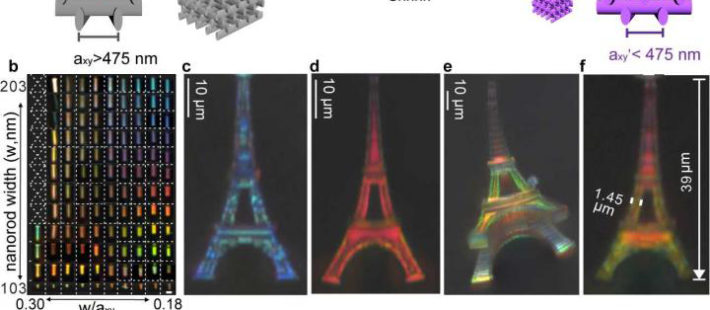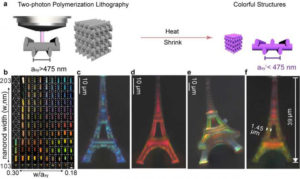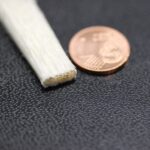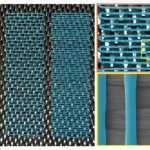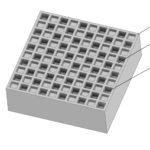Researchers have developed a “colouring-by-shrinking” method to print arbitrary 3D microscopic objects exhibiting structural colours. The design consisted of woodpile photonic crystals with varying lattice constants as the 3D building blocks. These structures remain colourless until they are heat treated, causing them to shrink and manifest colour, a result of their lattice constants shrinking down below the wavelength of visible light. The team printed a colourful microscopic Eiffel Tower with structural colours, demonstrating feature sizes smaller than 100 nm.
The smallest colourful 3D model of the Eiffel Tower without using pigments or inks
In a report recently published in «Nature Communications», a research group led by Associate Professor Joel Yang from the Singapore University of Technology and Design (SUTD) printed probably the smallest colourful 3D model of the Eiffel Tower. Impressively, no pigments or inks were used. Instead, the 3D-printed model of the Eiffel Tower, measuring less than half the width of a human hair at 39 micrometers, exhibits multiple colours due to the way light interacts with the nanostructures that hold up the model. The 3D models are made of a finely printed mesh of transparent polymer, forming photonic crystals. These mostly hollow designs remarkably shrink down in size by about 5 times when heated to produce a wide range of colours.
Prof Yang said: “There is great excitement in the research community to further develop sustainable sources of colours that aren’t extracted from animals or plants. What if the products that we make could derive its colour by nano-texturing of the material that it itself is made of? Certain butterflies and beetles have evolved to do this, perhaps we could learn to do this too.” Compared with pigments and dyes relying on chemical composition, structural colours are high-resolution, permanent, and eco-friendly.
In nature, the colouration of some butterflies, Pachyrhynchus weevils, and many chameleons are notable examples of natural organisms employing photonic crystals to produce colourful patterns. Photonic crystal structures reflect vivid colours with hues dependent on their lattice constants. To reflect vivid colours, the lattice constants of a photonic crystal must be sufficiently small. For example, the lattice constant is only ~280 nm on butterfly wings giving a blue hue of colour. Due to the limitation on current 3D printing resolution, it is a challenge to print arbitrary colours and shapes in all three dimensions at this microscopic length scale.
A “colouring-by-shrinking” method to print arbitrary 3D microscopic objects exhibiting structural colours
To achieve the required dimension of lattice constants comparable to the butterfly scales, researchers from Prof Yang’s group employed a “colouring-by-shrinking” method which introduces an additive heating step to shrink the photonic crystals printed using a commercial two-photon polymerization lithography system, i.e. the Nanoscribe GmbH Photonic Professional GT. Prof Yang added: “The challenge is in shrinking structures at these nanoscopic dimensions without having them coalesce into a blob. By patterning larger structures, and shrinking them later, we produced structures that could not have been printed directly with standard methods.” Indeed, the repeating lines of the woodpile structures were shrunk down to 280 nm, almost 2x smaller than the machine specifications. As a bonus side-effect of shrinking, the refractive index of the cross-linked polymer increased in the heating process, which further benefits the generation of colours.
The full-colour Eiffel Tower demonstrated the ability to print arbitrary and complex 3D colour objects at the microscale level using the “colouring-by-shrinking” method. With the freedom of designing 3D photonic crystals that are shrunk to fit specific colours, this technology would be broadly applicable to achieve compact optical components and integrated 3D photonic circuity operating in the visible region.
Journal Reference
Yejing Liu, Hao Wang, Jinfa Ho, Ryan C. Ng, Ray J. H. Ng, Valerian H. Hall-Chen, Eleen H. H. Koay, Zhaogang Dong, Hailong Liu, Cheng-Wei Qiu, Julia R. Greer, Joel K. W. Yang. Structural colour three-dimensional printing by shrinking photonic crystals. Nature Communications, 2019; 10 (1) DOI: 10.1038/s41467-019-12360-w
Story Source
ScienceDaily, Singapore University of Technology and Design (SUTD)
NOTE: Content may be edited for style and length.


